Address Interruptions in Cross-Border E-Commerce Servers

Understanding Server Process Abnormalities in E-commerce
In the rapidly evolving landscape of cross-border e-commerce, server process abnormalities and interruptions can significantly impact business operations. These technical challenges, particularly in US server hosting and colocation environments, require sophisticated monitoring and response mechanisms. Recent data indicates that 67% of e-commerce platforms experience server process issues at least once per quarter, making it crucial to implement robust solutions.
Common Types of Server Process Issues
- CPU Utilization Spikes: Unexpected resource consumption patterns
- Memory Leaks: Gradual degradation of available system memory
- Database Connection Failures: Intermittent or persistent query timeouts
- Network Connectivity Disruptions: Latency spikes and packet loss
- Storage System Bottlenecks: I/O performance degradation
Implementing Preventive Measures
Modern e-commerce infrastructure demands proactive monitoring and maintenance protocols. Here’s a systematic approach to preventing server process abnormalities:
- Deploy Advanced Monitoring Systems:
- Implement real-time performance metrics tracking
- Set up predictive analytics for anomaly detection
- Configure automated alerting mechanisms
- Establish Load Balancing:
- Configure dynamic resource allocation
- Implement geographic distribution of server loads
- Set up failover mechanisms
Emergency Response Protocols
When server processes fail, time is critical. Implement these emergency response procedures:
- Rapid Diagnostics Protocol:
- System log analysis
- Process tree examination
- Resource utilization assessment
- Process Recovery Steps:
- Automated service restoration
- Database consistency checks
- Cache clearing and optimization
Advanced Server Architecture Optimization
To enhance server stability for cross-border e-commerce operations, implementing sophisticated architecture optimizations becomes crucial. Modern hosting solutions require a multi-layered approach:
- Containerization Strategy:
- Microservices implementation
- Docker container orchestration
- Resource isolation protocols
- Database Optimization:
- Query performance tuning
- Index optimization
- Partitioning strategies
US Server Infrastructure Solutions
When selecting US-based server infrastructure for cross-border e-commerce, consider these technical specifications:
- Hardware Configuration:
- Enterprise-grade processors (minimum 32 cores)
- ECC memory configuration (128GB+)
- RAID 10 SSD arrays
- Network Architecture:
- Multi-homed BGP networking
- DDoS mitigation systems
- Global CDN integration
Performance Monitoring and Analytics
Implement these advanced monitoring solutions:
- Metrics Collection:
- Process-level resource utilization
- Network latency measurements
- Transaction response timing
- Analysis Tools:
- Time-series databases
- Machine learning anomaly detection
- Predictive maintenance algorithms
Future-Proofing Strategies
Prepare your e-commerce infrastructure for future challenges with these approaches:
- Automation Implementation:
- CI/CD pipeline optimization
- Infrastructure as Code (IaC)
- Automated scaling policies
- Security Enhancements:
- Zero-trust architecture
- Real-time threat detection
- Compliance automation
Conclusion
Effective management of server process abnormalities in cross-border e-commerce requires a comprehensive approach combining advanced monitoring, rapid response protocols, and sophisticated hosting solutions. By implementing these technical strategies and maintaining robust server infrastructure, organizations can significantly reduce downtime and enhance operational efficiency. Regular updates to both hardware and software components, coupled with proactive monitoring and maintenance, remain crucial for sustainable e-commerce operations.

